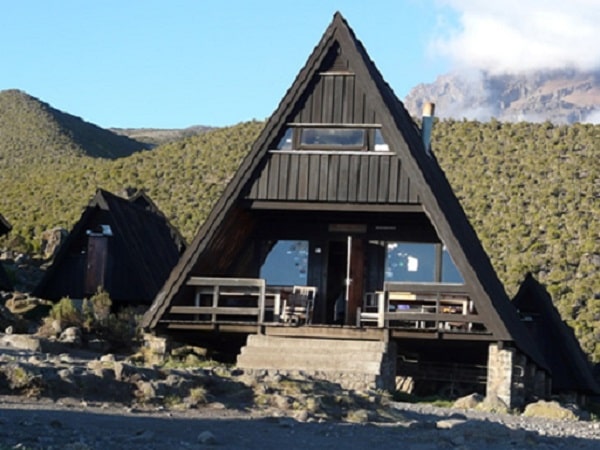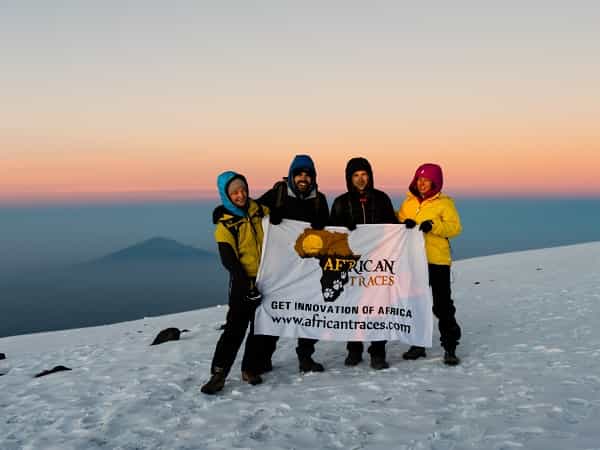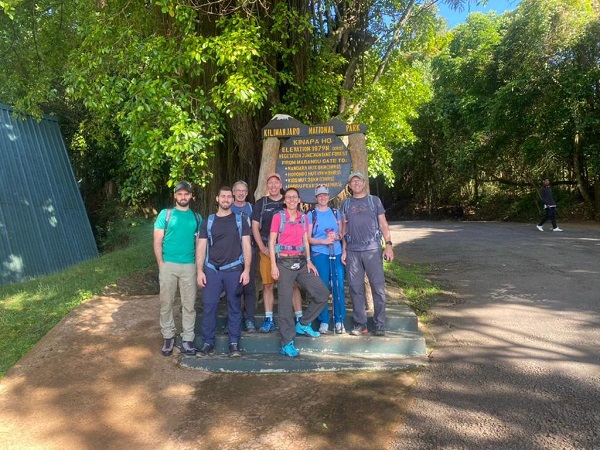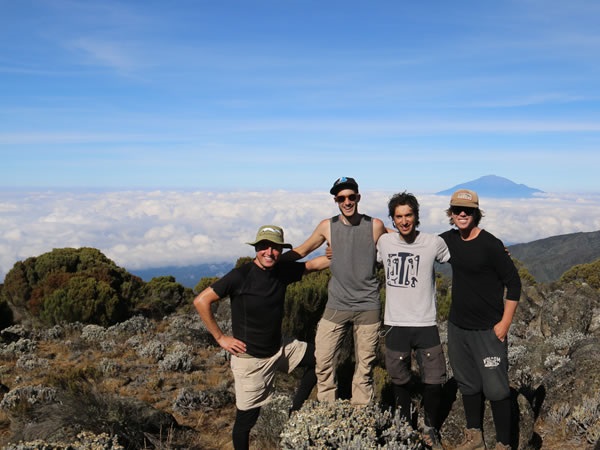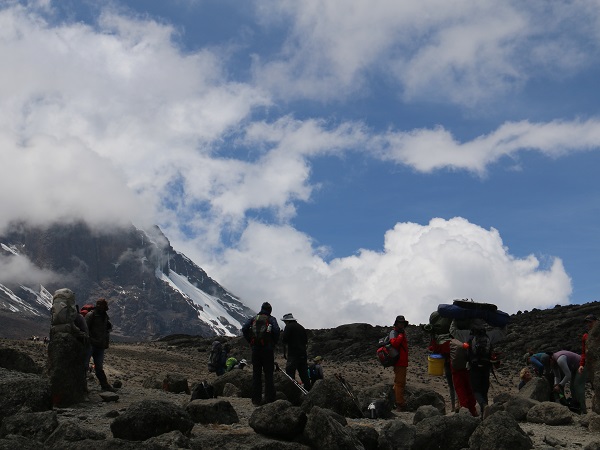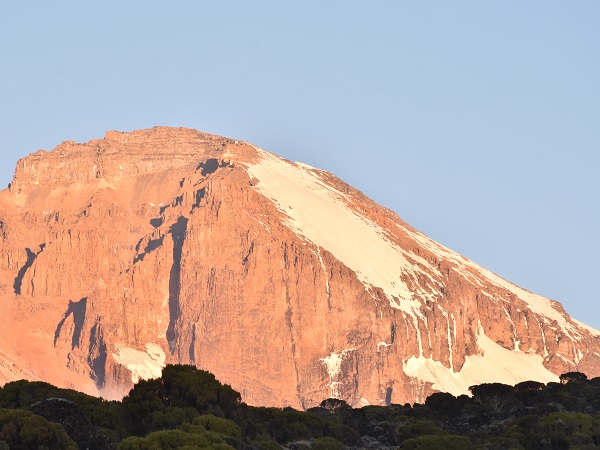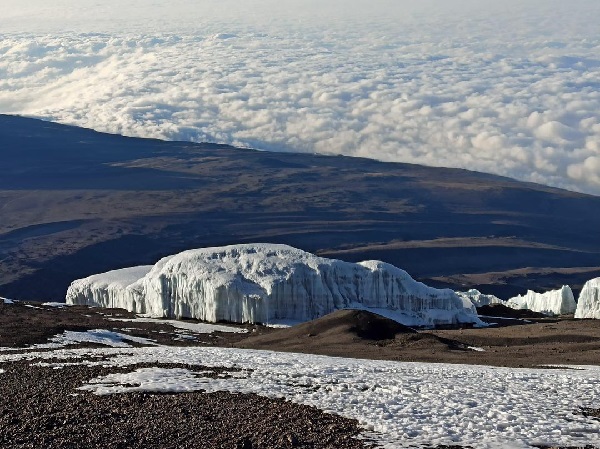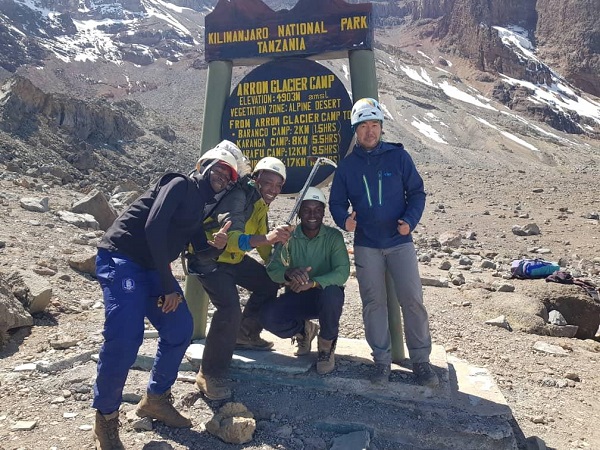Mount Kilimanjaro or just Kilimanjaro with its three volcanic cones Kibo,
Mawenzi, and Shira, is a dormant volcano in Tanzania. It is the highest mountain in Africa and
the highest single free-standing mountain in the world, with its summit of 5,895 metres
(19,341 ft) above sea level and at about 4,900 metres (16,100 ft) high from its plateau base.
Kilimanjaro is also the fourth most topographically prominent peak on Earth. The first people
known to have reached the summit of the mountain were Hans Meyer and Ludwig Purtscheller,
in 1889. The mountain is part of Kilimanjaro National Park and is a major climbing destination.
Because of its shrinking glaciers and disappearing ice fields, the mountain has been the subject
of many scientific studies
Kibo is the largest cone on the mountain and is more than 24 km (15 mi) wide at the Saddle
Plateau altitude. Kibo still has gas-emitting fumaroles in its crater.Kibo is capped by an
almost symmetrical cone with escarpments rising 180 to 200 metres (590 to 660 ft) on the south
side. These escarpments define a 2.5-kilometre-wide (1.6 mi) caldera caused by the collapse of
the summit.
Within this caldera is the Inner Cone and within the crater of the Inner Cone is the Reusch
Crater, which the Tanganyika government in 1954 named after Gustav Otto Richard Reusch, upon
his climbing the mountain for the 25th time (out of 65 attempts during his lifetime). The Ash
Pit, 350 metres (1,150 ft) deep, lies within the Reusch Crater. About 100,000 years ago, part
of Kibo's crater rim collapsed, creating the area known as the Western Breach and the Great
Barranco.
The origin of the name Kilimanjaro is not known, but a number of theories exist. European explorers had adopted the name by 1860 and reported that Kilimanjaro was the mountain's Swahili name. The 1907 edition of The Nuttall Encyclopedia also records the name of the mountain as Kilima-Njaro.
Johann Ludwig Krapf wrote in 1860 that Swahilis along the coast called the mountain Kilimanjaro. Although he did not offer any support. he claimed that Kilimanjaro meant either mountain of greatness or mountain of caravans. Under the latter meaning, kilima meant mountain and jaro meant caravans. Jim Thompson claimed in 1885, again without support. that the term Kilima-Njaro "has generally been understood to mean" the mountain (kilima) of greatness (njaro). He also suggested "though not improbably it may mean" the white mountain.
Njaro is an ancient Kiswahili word for shining. Similarly, Krapf wrote that a chief of the wakamba people whom he visited in 1849, "had been to Jagga and had seen the Kima jajeu, mountain of whiteness, the name given by the Wakamba to Kilimanjaro. More correctly in the Kikamba language this would be kiima kyeu, and this possible derivation has been popular with several investigators.
Others have assumed that kilima is Kiswahili for mountain. The problem with this assumption is that kilima actually means hill and is, therefore, the diminutive of mlima, the proper Kiswahili word for mountain. However, that an early European visitor, whose knowledge of [Kiswahili] was not extensive, changed mlima to kilima by analogy with the two Wachagga names: Kibo and Kimawenzi. A different approach is to assume that the kileman part of Kilimanjaro comes from the Kichagga kileme, which means that which defeats, or kilelema, which means that which has become difficult or impossible. The jaro part would "then be derived from njaare, a bird; or, according to other informants, a leopard; or, possibly from jyaro, a caravan". Considering that the name Kilimanjaro has never been current among the Wachagga people, it is possible that the name was derived from Wachagga saying that the mountain was unclimbable, kilemanjaare or kilemajyaro, and porters misinterpreting this as being the name of the mountain.
In the 1880s, the mountain became a part of German East Africa and was called Kilima-Ndscharo in German following the Kiswahili name components. On 6 October 1889, Hans Meyer reached the highest summit on the crater ridge of Kibo. He named it Kaiser-Wilhelm-Spitze (Kaiser Wilhelm peak). That name was used until Tanzania was formed in 1964. when the summit was renamed Uhuru Peak, meaning freedom peak in Kiswahili.
